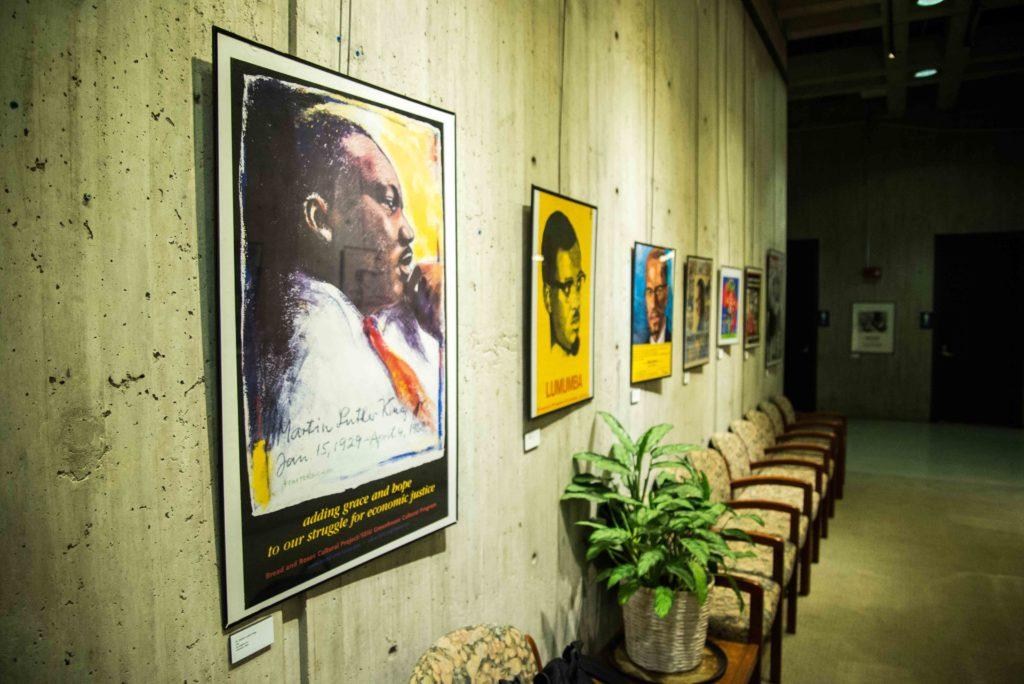By Mary Whitfill, editor-in-chief
City Hall is joining the ranks of Boston’s art museums and galleries this month as it features the multimedia works of local African-Americans. Two exhibits are now on display to honor talented ethnic artists across the city and celebrate Black History.
Curator John Crowley estimates that City Hall has hosted galleries for Black History Month for roughly 20 years.
“For Black History Month, going back, I’m sure they had artists and poets in mind and everything in between,” Crowley said. “Mayor [Martin] Walsh wants to highlight diversity in the neighborhoods… We don’t just show African-American artists during Black History Month, we show them all year.”
Hosted by the Mayor’s Office of Arts, Tourism and Special Events, Scollay Square Gallery features works by artists from the African-American Master Artist-in-Residence Program (AAMARP).
“We felt these works were current and that they addressed some issues people are thinking about in the city,” Crowley said.
The AAMARP gallery includes works done in crayon, ink, pastels, watercolors, acrylics and more as well as sculptures and photography.
“I think it’s a great idea. It gives local artists… free gallery space,” exhibit attendee Jeff Burton, 50, said. “It’s improving the questionable aesthetics of the inside of City Hall.”
Additionally, the Mayor’s Gallery on the fifth floor of City Hall presents the Black Leaders Poster Exhibition, a tribute to black leaders who rose to prominence despite discrimination. Martin Luther King, Jr., Malcolm X, Angela Davis and Nelson Mandela are among those featured.
“Initially, this history of the United States is the history of a racially-segregated nation,” Robin Chandler, associate professor in the Department of African-American Studies at Northeastern, said. “At a certain point, people of color and women were not invited into the social and cultural institutions of the time, and they created their own institutions. This is why we have African-American universities and insurance institutions, primary and secondary schools, etc.”
A City Hall worker who wished to remain anonymous said she felt the pieces brought attention to the plight of African-Americans.
“I think it’s really moving,” she said. “I think it’s really important people are aware of the African-American movement.”
The display of work from Northeastern’s in-residence program is just one of the many instances City Hall has sponsored AAMARP.
The AAMARP was founded in 1977 by Dana Chandler, a well-known African-American artist who began teaching at Northeastern in 1974. In October of ‘77, the program’s debut exhibition was held in City Hall’s Main Gallery, attracting over 3,000 visitors.
The residence program’s original mission was to provide studio space for black artists and raise awareness of talented African-Americans living and working in Boston.
“A culturally specific residency program for African-American artists gives them the opportunity to work in their own media and subject matter and gives them the studio space to make that happen,” Robin Chandler said. “In many cases, artists of color, unlike white artists, haven’t been able to afford the studio space that is sometimes necessary, especially if you are working in large media.”
Northeastern’s program was the first in the nation to provide an in-residence program to African-American artists. Robin Chandler was one of the original artists who were given space in the program. Today, a number of programs still exist in the Boston area that cater to ethnic artists and performers.
“Boston is trying to build up that reputation of promoting all types of artists to produce all kinds of work in a world-class city,” Robin Chandler said.
According to her, it is this acceptance of a variety of artists that influences the look of the city.
“There used to be a lot of murals in Boston that were created by African-American and Latino artists going back to the 1960s,” she said. “Very few are still up. I think there are some, and I think Boston has gone through a transformation. The integration of different kinds of artists and art production has changed the way the city and the region look.”
Both exhibits are on display and open to the public through Feb. 28.
Photo by Scotty Schenck







![A demonstrator hoists a sign above their head that reads, "We [heart] our international students." Among the posters were some listing international scientists, while other protesters held American flags.](https://huntnewsnu.com/wp-content/uploads/2025/06/image12-1200x800.jpg)







